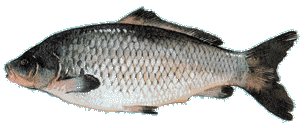|
|
|
||||||||||||||||||
|
|
Indigenous to Asia carp was introduced to the west from Germany in 1876. Carp is farmed in more than 30 countries and is a favorite in Asian and European Cuisines With flaky white coarse-textured fish which sometimes has a sweet flavor, depending on its habitat, with soft moist flesh fish that is often not held as a high quality fish due to its sometimes muddy flavor. Farmed Carp have a milder and more desirable flavor. The carp fisheries of the Great Lakes are mainly in Lake Michigan, Huron, and Erie, but together they produce less than half of the quantities produced in the Mississippi. The carp grows to a weight of 30 lbs but averages 2 to 8 lbs., the 3 to 5 pounders are considered to have better flavor than the larger ones and the carp is of best quality during the cold winter months Carp is sold live and after being caught it is placed in water that should be changed every few days to remove the muddy taste. Baking on the bone and braising are two popular preparation techniques. The mild flavor of carp is highlighted by sauces with a hint of sweetness. Remove the midlateral strip of darker flesh before cooking--it can infuse the meat with a strong, musky flavor. Carp also fries, and poaches nicely. It is also the main ingredient in the Jewish dish "gefilte fish," and is popular in Chinese cuisine. Carp roe may be cooked in a similar fashion to shad roe Season December to July with the largest quantities available in April
|
||||||||||||||||||
|
|
|||||||||||||||||||

